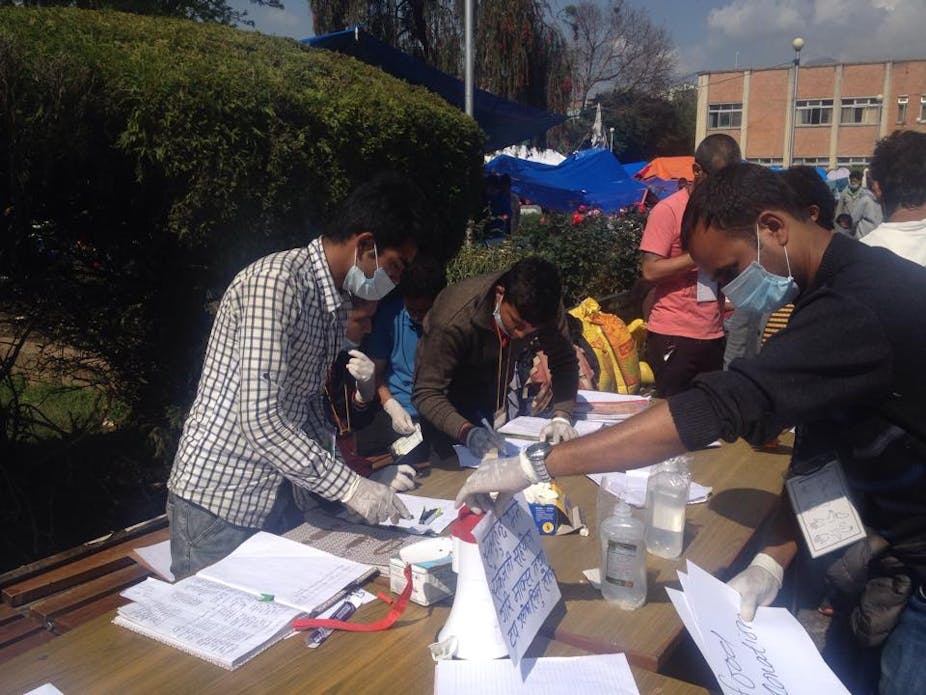The magnitude 7.8 earthquake in Nepal was one that many had anticipated, although there was little strategic planning or advance preparation.
The youthful tectonic plate wrinkle called the Himalayas was long overdue to shake up the region.
The initial days after the quake have proven unstable and insecure, both literally in terms of the hourly aftershocks that have made sleep impossible and politically in the global response to this disaster.
This event threatens to become a catastrophe, largely because of the difficult relationship that has long existed between Nepal and the international development industry.
Old patterns
As aid arrives into the country, old patterns are emerging.
International aid responses have mimicked the petty bureaucratization that hampered reactions in Haiti in 2010. Diplomatic and political concerns are taking precedence over saving lives, as they did in New Orleans in 2005.
Likewise, Nepal’s own governmental instability is staying the course, as politicians unable to write a constitution for seven years are proving (unsurprisingly) also unable to direct relief within their own country, although they are showing a strong desire to control priorities.
Having closely watched Nepal’s interactions with the development apparatus for some time now, I believe there here is an opportunity to change the patterns of behavior that have made the development industry a domain of despair rather than hope.
To do this, two groups have to behave differently – the Nepali people and the global public sphere.
Only the first have already taken up the challenge.
Civic engagement on the ground
I find myself glued to my computer, watching with amazement as youth groups mobilize to send support to inaccessible areas.
As one of my research collaborators said,
“my family is okay but other things are very bad here. I took my family to a safer place and now we youth are sending volunteers, medicine, tents and food to villages.”
A group called “Bibeksheel Nepalis” or “Responsible Nepalis” is organizing online to send volunteer teams to various neighborhoods to distribute supplies and recruit those with vehicles to rescue the injured.

Dozens of social service organizations in Nepal’s vibrant civil society like the Association of Youth Organizations of Nepal (AYON) have set up bases under whatever tarps they can find to protect them from the rain and are organizing water distribution and creating emergency supply kits.
This is a citizenry that has long known it cannot rely on its government, and in this time of crisis one sees the very best of the country’s character.
Nepal cannot wait seven years for water or electricity as it has waited futilely for seven years for a constitution.
Too much attention to Everest climbers
I am less confident about the international community’s ability to change their modes of response to distant disasters.
Far too much media coverage has focused on Mount Everest and climbers.
While we all mourn those who died on Sagarmatha, there are pressing issues across the country. Every few hours I receive messages from friends and colleagues across Nepal describing their decimated villages and how they have yet to see anyone from the outside.
Unreachable except by helicopter at present, these remote towns will not make the cover of the newspaper. If events like Haiti and Fukushima have taught us anything, it is that recovery from disaster is both a short and a long-term process.
It is incumbent upon everyone to learn more about this event that is becoming a catastrophe – to look beyond the celebrity endorsements and heart-wrenching stories to ask questions about the region, about aid efforts and how priorities are being set.
In the current era of clickable humanitarianism, it is easy to text-to-donate for the latest cause and then move on to the next social media event.
Short and long-term recovery
Currently, there is desperate need to get bandages, clean water and medical teams to remote areas quickly. Even as that immediate need occurs, we are also seeing preventable secondary calamities erupt.
People are sheltering in tents out of fear of aftershocks and the limited-sanitation provided in these open-air camps provide the ideal conditions for a cholera epidemic.

Without a forwarding-thinking aid plan, these concerns could last for years and kill far more people than the initial quake.
Latrines are not a great seller on social media.
In both acute crises and long-term development, aid priorities are often overwhelmed by politics - both national and international.
Soon, we will approach a stage where a more substantial and long-lasting process of rebuilding will begin, a new area that will require foreign aid to serve civil society, not the reverse.
But Nepal’s relationship to international aid is deeply conflicted.
Nepalese scholars like Dor Bahadur Bista, Nanda Shrestha, and Devendra Raj Panday question the progress that more than a half century of engagement with development has brought to Nepal. These authors suggest that the priorities of aid in Nepal have often been decided by Nepal’s elites or the donor countries’ and organizations’ priorities, rather than the needs of the people.
A silver lining?
The devastation of this earthquake provides an opportunity for a new mode of international development, one that is driven by voices on the ground, rather than the ever-changing fashions of the aid industry.
Connecting people to people, without the politics of government or the bureaucratization of the traditional aid community is the best hope for Nepal’s recovery.
This would require caring members of the global community to do some research, move beyond the easy-to-click buttons, and understand more about the situation in Nepal - and then demand that the organizations they give to do the same due diligence.
The youth of Nepal are stepping forward to rebuild their own country. The least the international aid community and the world can do is meet them half-way.

